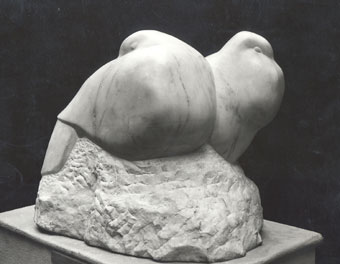There was a program about Barbara Hepworth on television last week (The Culture Show on BBC), and I have been thinking about it since. It included some black and white footage of Hepworth at work, and audio of Hepworth speaking about herself, her practice, and art in general. I did not see the full show as I had to go out on a previously engaged bike ride. Unfortunately I can not find the show online, but here is another interview by Hepworth:
Perhaps it was a fair sacrifice--giving up the TV program for riding the bike in fresh air--one Hepworth might make herself, considering she was interested in the nature and landscape. She also used a word akin to primitive, primary, primordial, primal, or eternal on the show. I can't be sure which word it was anymore... I am thinking about the primary shapes myself: the circle, triangle, square. I do like them. Plus I find it amazing just how many painters and draftsmen/women are turning to the primitives as a subject. I enjoy their work as well. But a bee buzzes somewhere...
The question of existence,
The question of existence as an artist,
The question of existence of an artwork made by the artist,
Is there an eternal, spiritual, primal, abstract, concentrated answer to these questions? One can 'feel' these questions, and proceed to 'think' of them. To feel their answer in a primary form, a platonic form, a form smoothened or neutralized... I am not sure...
John Berger has a lovely essay on Brancusi and his forms in the book 'The Shape of a Pocket' [121-7]. In describing a blind person's reactions when holding Brancusi's 'Sculpture for the Blind,' Berger imagines them asking, "Is this thing I'm holding a container or a core?" Berger says that when carving Brancusi "wanted to go back, eliminating all imperfections, all wear and tear, to the growing point of the first Creation, to the pure idea as it takes on form. Platonic once more." Berger feels when the sculptor succeeded when he created a core. But Berger brings up the question that Brancusi might himself have felt, i.e. how long can one keep pursuing the platonic?
 |
| Constantin Brancusi Sculpture for the Blind ca. 1920 Veined Marble |
Hepworth's interviews brought up the word 'primal.' And that brings up for me the search for meaning... it troubles me, or perhaps it calls me... It calls me because I know that question. It troubles me because firstly because the word 'primitive' etc seems to have a colonial ring to it. And also I am realizing that a platonic shape can not exist in reality, it may only seem to exist in representation. And as no perfection is possible... 'perfection' of form is imperfect. [Imperfection as texture or pattern... that is an interesting idea.] Maybe I feel that tool marks on an imagined platonic form are a ruse, not a testimony to a human spirit that is reaching towards that which is perfect. The form really must be imperfect, more unique. Of course it all depends on the point of view, and what carries an urgency on a person to person, situation to situation basis. I need to see and read a bit more about Hepworth to see what she was after. Maybe it will help me figure out the same for me.
 |
| Barbara Hepworth, Two Forms in Echelon, Bronze, 1961 |
 |
| Barbara Hepworth, Doves (Group), Parian marble, 1927 (BH 3), Manchester City Art Gallery |
No comments:
Post a Comment